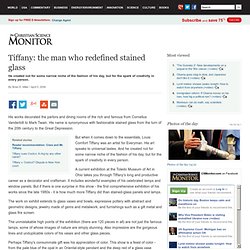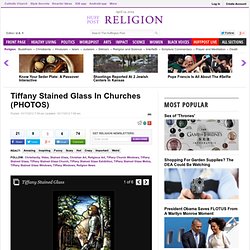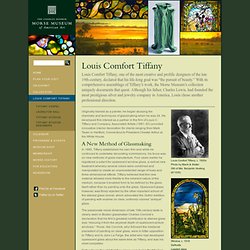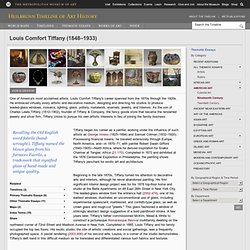

Microsoft Word - 2009_11_Louis_Comfort_TIFFANY.doc - 2009_11_Louis_Comfort_TIFFANY.pdf. Tiffany Stained Glass Trail. Tiffany: the man who redefined stained glass. By Brian E.

Miller / April 5, 2006 His works decorated the parlors and dining rooms of the rich and famous from Cornelius Vanderbilt to Mark Twain. His name is synonymous with fashionable stained glass from the turn of the 20th century to the Great Depression. Skip to next paragraph Subscribe Today to the Monitor Click Here for your FREE 30 DAYS ofThe Christian Science MonitorWeekly Digital Edition But when it comes down to the essentials, Louis Comfort Tiffany was an artist for Everyman.
A current exhibition at the Toledo Museum of Art in Ohio takes you through Tiffany's long and productive career as a decorator and craftsman. The work on exhibit extends to glass vases and bowls, expressive pottery with abstract and geometric designs, jewelry made of gems and metalwork, and furnishings such as a gilt metal and glass fire screen. The unmistakable high points of the exhibition (there are 120 pieces in all) are not just the famous lamps, some of whose images of nature are simply stunning.
Louis Comfort Tiffany Online. Tiffany Windows: Stained Glass Pattern Book: Amazon.fr: Connie Eaton: Livres anglais et étrangers. Louis C. Tiffany Stained Glass Windows in Western New York. Tiffany Stained Glass In Churches (PHOTOS) Loading Slideshow Sir Galahad, Cryder Memorial Window, 1910Tiffany Studios, New York Sir Galahad, Cryder Memorial Window, Before 1910 Leaded glass, 45 x 27 1/4 inches.

St. Andrew’s Dune Church, Southampton, New York Sir Galahad is a figure of Arthurian Legend who was one of the Knights of the Round Table and the son of Sir Lancelot. He was known as an example of purity and chastity and was sent on Arthur’s quest for the Holy Grail. During his travels, he rode on King Solomon’s ship, obtained the Sword of King David, and carried a white shield painted with the blood of Joseph of Arimathea, the wealthy man who removed Jesus’s body from the cross and brought him to the tomb. Hide Thumbnails 2 Points Editor's note: Louis C. In creating stained-glass windows, Tiffany drew on a wide range of subjects and historical styles and references while imbuing them with remarkable artistry and incorporating both traditional and innovative techniques in glass making.
Also on HuffPost: Louis Comfort Tiffany - World's Most Comprehensive Collection. Originally trained as a painter, he began studying the chemistry and techniques of glassmaking when he was 24.

He developed this interest as a partner in the firm of Louis C. Tiffany and Company, Associated Artists (1881–83) provided innovative interior decoration for clients ranging from Mark Twain in Hartford, Connecticut to President Chester Arthur at the White House. A New Method of Glassmaking In 1885, Tiffany established his own firm and while he continued to undertake decorating commissions, his focus was on new methods of glass manufacture. Four years earlier he registered a patent for opalescent window glass, a radical new treatment whereby several colors were combined and manipulated to create an unprecedented range of hues and three-dimensional effects.
Both schools thought that they alone were being "truthful," an ideal central to the philosophy of the Arts and Crafts movement. Inspired By Nature International Acclaim Dumbfounding Versatility. Louis Comfort Tiffany (1848–1933) One of America's most acclaimed artists, Louis Comfort Tiffany's career spanned from the 1870s through the 1920s.

He embraced virtually every artistic and decorative medium, designing and directing his studios to produce leaded-glass windows, mosaics, lighting, glass, pottery, metalwork, enamels, jewelry, and interiors. As the son of Charles Lewis Tiffany (1812–1902), founder of Tiffany & Company, the fancy goods store that became the renowned jewelry and silver firm, Tiffany chose to pursue his own artistic interests in lieu of joining the family business. Tiffany began his career as a painter, working under the influence of such artists as George Inness (1825–1894) and Samuel Colman (1832–1920). Possessing financial means, he traveled extensively through Europe, North America, and—in 1870–71, with painter Robert Swain Gifford (1840–1905)—North Africa, where he derived inspiration for Snake Charmer at Tangier, Africa (21.170). Stained Glass in the School Art Curriculum - stainedglass.pdf. Stained Glass Math Activity. Stained Glass Window is a project that requires students to graph linear equations in order to create a colorful (yet mathematical) display window.

Each student selects and graphs at least twelve linear equations from the equation bank to create their own unique stained glass window. This visual/kinesthetic project will help students to clearly identify the equations of horizontal and vertical lines and to easily distinguish between positive and negative slope. Key graphing vocabulary can also be developed during the project.